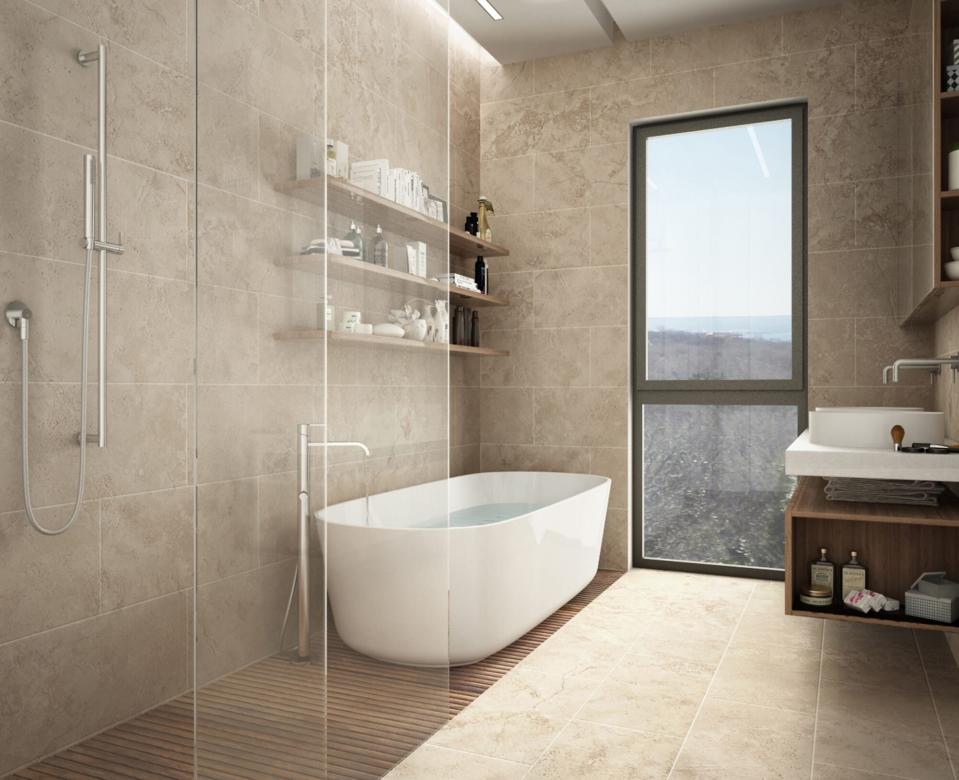Everything You Need to Know About Travertine Tile, the New Neutral Your Modern Home Is Missing
Travertine tile is trending and it's not difficult to understand why. Softer than granite, but stronger than marble, travertine is formed from mineral deposits found in natural hot springs and has a unique textured and layered appearance, Deborah Osburn, the founder of Clé Tile, says. It also won't break the bank: "Travertine can prove a surprisingly affordable stone, while still being able to provide the upscale visual attributes of pricier finishes," she says.
Earthy yet sleek, this medium can be cross cut to yield an "opaque, cloudy appearance," or vein cut for a more "contemporary, linear" feel, notes Joshua Levinson, CEO of Artistic Tile. "When polished, the natural brilliance of travertine is brought forward, whereas a honed finish offers a muted, organic look," he explains. "Depending on usage and aesthetic, the natural holes in the stone can be filled with either a cement based or resin based filler, or left unfilled." Interested in learning more about the season's hottest tile type? From the best places to install travertine to tips for keeping it in tip-top shape, Osburn and Levinson share their insight, ahead.
Related: Four Questions to Ask Yourself When Choosing a Stove Backsplash

ArchiViz / Getty Images
Travertine isn't a modern invention.
The use of travertine dates back to the Roman era, when it was used to construct some of Italy's most iconic architectural gems, including the Baroque-style colonnades at St. Peter's Square in Vatican City, explains Levinson. "The ancient Romans used this extensively, exploiting the famous Travertine Quarries in Tivoli," he adds. "The cladding on the Colosseum is made of travertine, and the material was used often within Roman baths."
It works well in highly trafficked areas.
Sturdy and sophisticated, Osburn says travertine tiles are a great choice for high-touch spaces of your home, including backsplashes, countertops, floors, walls, and fireplace surrounds. "It can provide a sturdy surface for many areas," she explains. "Bathrooms and showers are great spaces to use travertine, and for floor use, it provides more slip resistance than most stone surfaces." Since travertine doesn't have the ability to absorb heat, Osburn says it's becoming a popular choice for outdoors, as well. "However, outdoor use should be restricted to warm climates, because freezing water and temperatures can weaken the stone," she explains.
It's the new neutral.
Depending on the cut and finish, Levinson says this medium can complement a wide range of aesthetic styles. "Vein cut travertine is linear in formation, offering a more contemporary look," he explains. "However, if you change the finish and cut, it can work just as well in a more rustic environment." Thanks to its earth-toned coloring and linear veining, Osburn says this tile can echo the appearance of natural wood grain, creating an especially versatile, organic vibe. "Like wood, travertine is primarily monotone and can easily be incorporated as a muted accent into any style of space," she says.
And since travertine typically appears in cream or buff hues, Osburn notes that the tile can be used in a variety of color palettes. "Currently, it lends soft texture to spaces that are all neutral, and is having the biggest comeback in spaces using pale desert tones. However, it also lightens up a dark palette by offering a quiet surface, instead of a bold contrast."
Seal travertine when you install it.
Upon installation, Levinson says your travertine surfaces should be sealed with a natural stone sealant to protect them from stains. He also strongly recommends keeping acidic cleaning solutions away from natural stone. "Travertine is a calcium carbonate-based stone, making it vulnerable to chemical attack, so make sure your cleaner is pH neutral," he advises. "It's also common for new holes to open up in the travertine, but they can be filled with a cement-based or resin-based filler (depending on what type was originally applied)."

